Despite being a strong advocate of plasma display technology, Panasonic has continued to release LCD televisions to cater for buyers who are unable to make room for larger-sized plasmas. 6 weeks ago, no less than 7 new LCD ranges (the C10, X10, X15, S10, G10, G15, and V10 series) were launched at the Panasonic Convention 2009 in Amsterdam; today, we’ll have a proper look at the smallest model in the G10 LCD series, the 32-inch Panasonic TX-L32G10.
<!-- google_ad_client = 'pub-2887677957235196'; google_ad_slot = '4990177225'; google_ad_width = 336; google_ad_height = 280; //-->
Besides a true HD native screen resolution of 1920 x 1080 (though it’s debatable whether you can fully appreciate this on a 32″ screen from normal seating distances), another main selling point of the Panasonic TX-L32G10 is its integrated Freesat tuner. Freesat, of course, is the UK free-to-air digital satellite TV service that lets you watch high-definition content on certain channels (BBC HD, ITV HD, Luxe HD) without having to pay for a subscription.
Note: The specific model we reviewed was the Panasonic TX-L32G10B… the character “B” appended to the end of the model number refers to the 3-pin-plug British version.
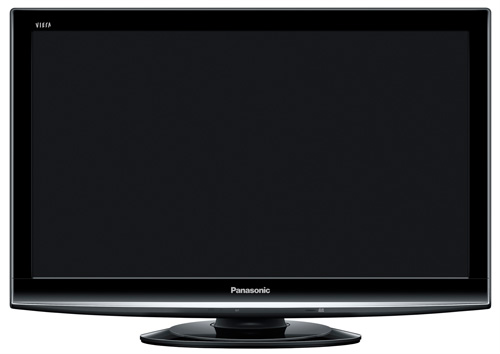
From its polished black bezel and boxy shape, to the biconvex silver strip that separates the logo and the subtly curved bottom border of the panel, the TX-L32G10 LCD HDTV does not deviate too much from Panasonic’s solid if unspectacular design philosophy. Whereas its predecessor (the TX-32LZD81) sported a pre-attached cuneiform pedestal stand, the one that comes with the Panasonic TX-L32G10 has an oval base, does not swivel, and is packaged separately inside the shipping box.
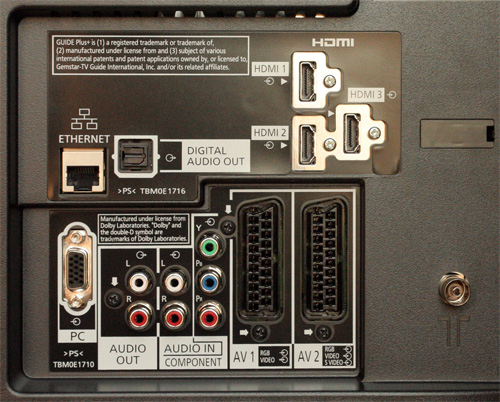 |
| Rear: 3 x HDMI, VGA, component, 2 x Scarts, aerial, Freesat (not shown), LAN, audio outs |
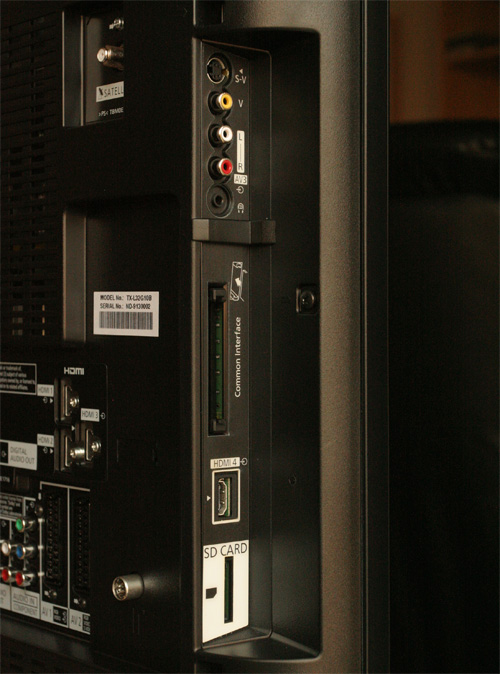 |
| Side: HDMI, S-video, composite, CI slot, SD card slot, headphone out |
Just like all Panasonic consumer-grade flat screen televisions we’ve reviewed to date, the TX-L32G10 lacks white balance controls in its user menu for full greyscale calibration, so we’ve had to make do one of the three [Colour Balance] presets (“Cool“, “Normal” and “Warm“). As expected, [Colour Balance] “Warm” in “Cinema” [Viewing Mode] came closest to D65 industry standard:
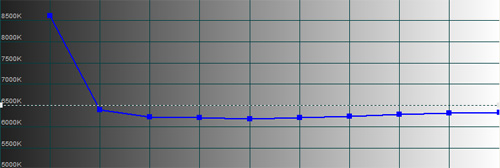 |
| CCT of [Colour Balance] “Warm” in [Cinema] mode |
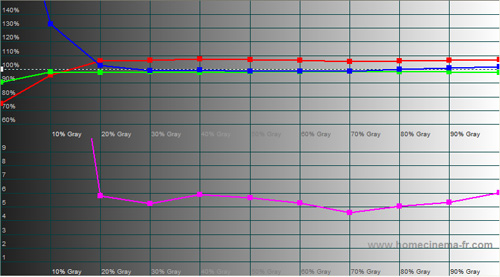 |
| RGB tracking and delta errors (dEs) with [Colour Balance] “Warm” |
There remained a tinge too much red in the greyscale, but thankfully, casual users generally shouldn’t notice this subtle degree of deviation in day-to-day viewing.
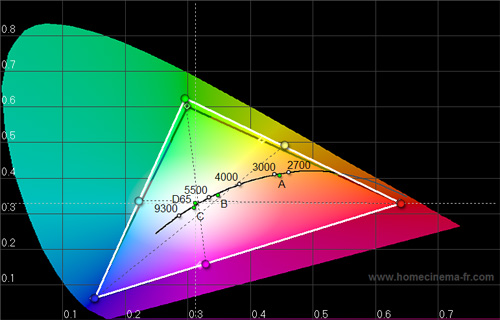 |
| Panasonic TX-L32G10 CIE chart with reference to HD Rec. 709 |
The colour gamut on our Panasonic TX-L32G10 sample unit came reasonably close to high-definition Rec. 709 reference. Green primary was slightly oversaturated, but at least hue was aligned… an improvement from the wildly oversaturated and bluish green primary colour point on most Panasonic plasmas we’ve tested. Unfortunately, we detected some red push (a colour decoding error which cannot be inferred from the CIE diagram alone) on the Panasonic TX-L32G10, which – together with the deviated yellow and (to a lesser extent) magenta secondary colour points – will no doubt impair the realism of skin tones.
| Dead pixels | None |
| Screen uniformity | Excellent |
| Overscanning on HDMI | 0% with [Picture Overscan] set to “Off“ |
| Blacker than black | Passed |
| Black level | Average |
| Black level retention | Stable in “Cinema” [Viewing Mode] |
| Primary chromaticity | Very good |
| Scaling | Good |
| Video mode deinterlacing | Good; effective jaggies reduction |
| Film mode deinterlacing | Failed 3:2 and 2:2 cadences in all resolutions |
| Viewing angle | Excellent for an LCD TV (120-130°) |
| Motion resolution | [Intelligent Frame Creation] “Max”: 850; “Mid”: 900; “Off”: 250 |
| Digital noise reduction | Acceptable at baseline |
| Sharpness | Very mild non-defeatable edge enhancement |
| 1080p/24 capability (PS3) | Accepts 1080p/24 video signal; no telecine judder |
| Input lag (rel. to Samsung F96) | 0ms in “Game” [Viewing Mode]; 15ms otherwise |
| Default “Normal” [Viewing Mode] | 91 watts |
| Calibrated “Cinema” [Viewing Mode] | 78 watts |
| Standby | <1 watt |
Although the advanced IPS-alpha panel on the Panasonic TX-L32G10 HDTV excelled at delivering wide viewing angles (for an LCD TV), blemishless screen uniformity and smear-free motion, its Achilles’ heel was always going to be in the critical area of black-level performance, which is of course not helped by Panasonic’s persistent omission of backlight control from their LCD televisions (only in the UK… the US versions do offer backlight adjustment control).
In “Cinema” [Viewing Mode], calibrated black level on the Panasonic TX-L32G10 measured at a distinctly average 0.26 cd/m2. Some dynamic dimming wizardry (e.g. by switching the [Viewing Mode] to “Standard“) can lower this to an impressive 0.04 cd/m2 (achievable only when the content displayed on screen is totally black), but of course, gamma/image contrast, shadow detail and highlights will suffer as a result of the fluctuating nature of this picture processing method.
![Gamma in [Cinema] mode](https://www.hdtvtest.co.uk/news/wp-content/uploads/2018/04/hdtv_Panasonic-TXL32G10_gamma-cinema.jpg) | ![Gamma in [Standard] mode](https://www.hdtvtest.co.uk/news/wp-content/uploads/2018/04/image_hdtv_Panasonic-TXL32G10_gamma-standard.jpg) |
| Gamma in [Cinema] mode | Gamma in [Standard] mode |
Using Chapter 31 of the “FPD Benchmark Software For Professional” test disc as our reference, we recorded a motion resolution of 900 on the Panasonic TX-L32G10 with [Intelligent Frame Creation] set to “Mid“. After the Sony Z4500 which boasts 200Hz Motionflow technology, this is the joint second highest (with the Philips 9632) among all the LCD televisions we have tested to date. Also impressive was how clean and halo-free the motion interpolations were.
Paradoxically, cranking [Intelligent Frame Creation] up to “Max” actually dropped the Panasonic TX-L32G10’s motion resolution to 850, due to the introduction of some more undefeatable edge enhancement which obscured the finer lines.
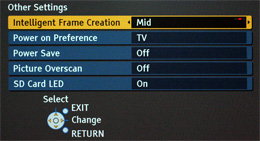 | 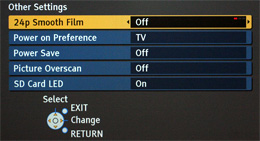 |
| [Intelligent Frame Creation] | [24p Smooth Film] |
Disabling [Intelligent Frame Creation] further reduced motion resolution to 250 – the norm for LCD panels not equipped with MCFI (motion-compensated frame interpolation) technology. [24p Smooth Film] – a menu option which only presents itself when the Panasonic TX-L32G10 is fed with 1080p/24 video signal – had no effect on motion resolution.
The Panasonic TX-L32G10 LCD HDTV smoothened jagged edges effectively for video-based material, but failed to detect 3:2 and 2:2 cadences (over 480i and 576i respectively) for film mode deinterlacing, which means that film-based content such as movies and American dramas will be tarnished with deinterlacing artefacts like moire and line twitter. Whether or not these artefacts will be visible to you depends on your viewing distance (the farther you are, the less likely you’ll see them), any confounding factors (a low bit-rate broadcast will present other problems which are more noticeable), and your own ability to recognise these deinterlacing artefacts in the first place.
Of course, you can easily sidestep the Panasonic TX-L32G10’s deficiency in film-based deinterlacing by feeding the television with progressive video signal from a competent device (i.e. letting your DVD player perform the deinterlacing).
Standard-def images from the inbuilt tuners appeared slightly flat and “filtered”, possibly due to hardcoded MPEG noise reduction which inadvertently blurred away some genuine fine details on top of undesirable MPEG compression artefacts. This is a shame, because the upscaling/ upconversion quality on the Panasonic TX-L32G10 LCD TV was actually quite good: when piped through HDMI at 576p, decent SD DVDs looked sufficiently sharp and detailed on the TX-L32G10 without too much ringing.
Because of the aberrated yellow secondary colour point and mild red push, flesh tones on the Panasonic TX-L32G10 flat screen television struggled to convince. Setting [Colour Balance] to “Normal” alleviated the problem somewhat, but of course this would bump greyscale in excess of 6500K which, at the end of the day, is still preferable to sickly skin tones.
Switch to HD content, and naturally things looked a whole lot better, thanks largely to sharper detail from increased resolution, and richer colours from greater tonal depth.
If you already have a Sky dish installed, or stay in an apartment connected to a communal satellite dish, then the Freesat tuner on the Panasonic TX-L32G10 will provide you with the cheapest (especially pertinent in the current credit crunch) source of high-definition content you can find in the United Kingdom. Sure, only a couple of HD channels are available at the moment, but trust us, the few occasions when you can feast your eyes on HD sport broadcasts that are sharply detailed and free of mosquito noise will make it entirely worthwhile.

Freesat aside, the Panasonic TX-L32G10 HDTV also dealt with 1080p/24 video signal fed from a Sony PS3 impeccably: we saw no evidence of telecine judder when watching Forgetting Sarah Marshall (Blu-ray) even with [24p Smooth Film] set to “Off“. Activating this feature would stabilise the 24p flicker (most visible on vertically scrolling text), but introduce a mild video-like effect which, to be fair, was much more subtle than most of the dejuddering processing found on other flat panel televisions.

Compared to other HDTVs boasting deeper blacks, colours on the Panasonic TX-L32G10 LCD television didn’t really leap off the screen, but remained natural enough to satisfy. Although there persisted a tiny trace of non-defeatable edge-enhancement even with [Sharpness] set to minimum, the Panasonic TX-L32G10 (with [Picture Overscan] disabled) portrayed fine detail crisply. However, unless you’re sitting less than 4 feet away, we think that a full HD resolution of 1920×1080 is probably an overkill for a screen of this size (i.e. you’ll find it difficult to appreciate the difference between this and a HD ready resolution of 1366×768 on a 32-inch screen).
With “Game” [Viewing Mode] engaged (this will disable [Intelligent Frame Creation]), the Panasonic TX-L32G10 offered good gaming response – its measured input lag was on par with our resident Samsung F96 reference. Using any other [Viewing Mode] besides “Game” would add 15ms to the input lag.
While its ordinary black level prevents us from recommending it for critical viewing, the Panasonic TX-L32G10 LCD may appeal as a daytime or bedroom/study/kitchen TV especially to gamers (lowish input lag), sports fans (clean and clear motion), and those who wish to enjoy Freesat HD content without forking out for a separate box.

<!-- google_ad_client = 'pub-2887677957235196'; google_ad_slot = '0693194791'; google_ad_width = 336; google_ad_height = 280; //-->